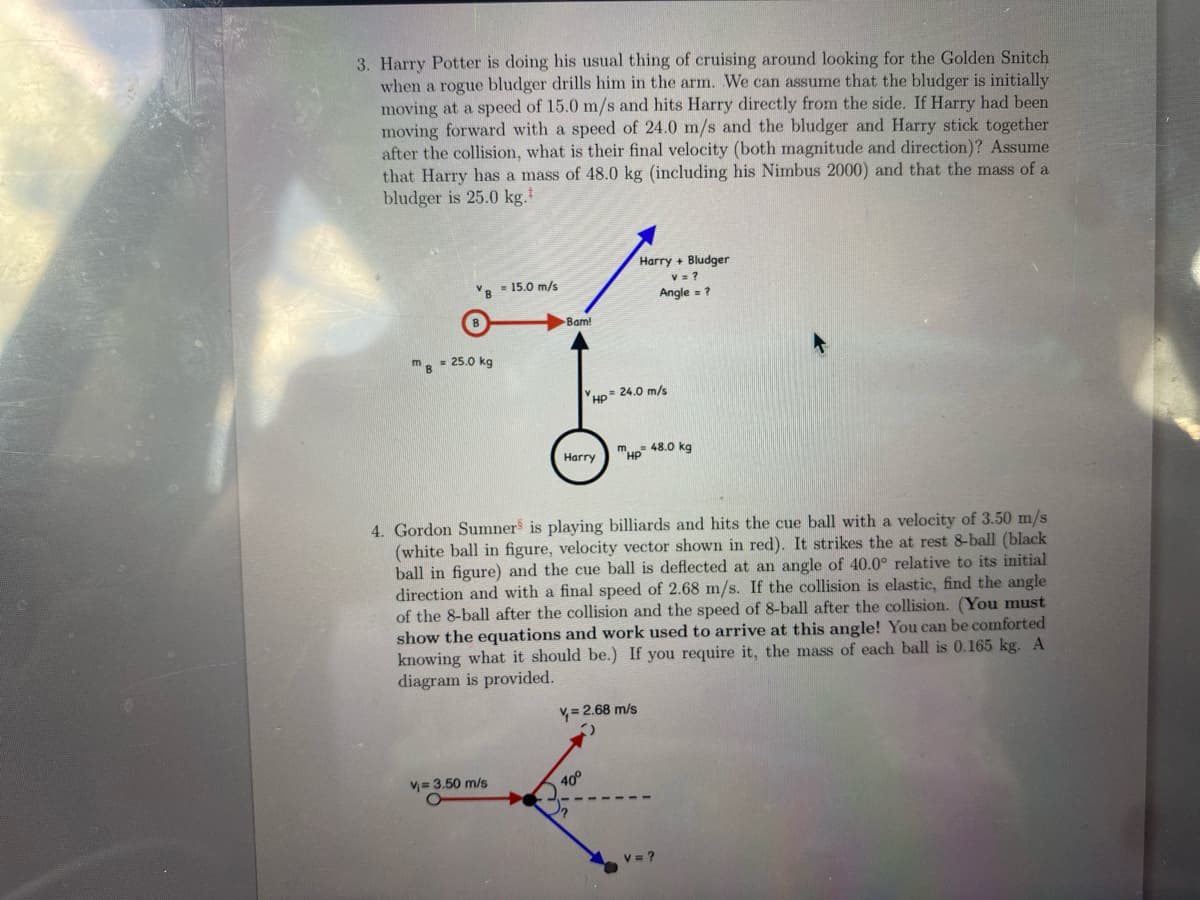3. Harry Potter is doing his usual thing of cruising around looking for the Golden Snitch when a rogue bludger drills him in the arm. We can assume that the bludger is initially moving at a speed of 15.0 m/s and hits Harry directly from the side. If Harry had been moving forward with a speed of 24.0 m/s and the bludger and Harry stick together after the collision, what is their final velocity (both magnitude and direction)? Assume that Harry has a mass of 48.0 kg (including his Nimbus 2000) and that the mass of a bludger is 25.0 kg. m B = 25.0 kg B = 15.0 m/s Bam! Harry+Bludger v = ? Angle = ? 24.0 m/s HP 48.0 kg Harry HP 4. Gordon Sumner is playing billiards and hits the cue ball with a velocity of 3.50 m/s (white ball in figure, velocity vector shown in red). It strikes the at rest 8-ball (black ball in figure) and the cue ball is deflected at an angle of 40.0° relative to its initial direction and with a final speed of 2.68 m/s. If the collision is elastic, find the angle of the 8-ball after the collision and the speed of 8-ball after the collision. (You must show the equations and work used to arrive at this angle! You can be comforted knowing what it should be.) If you require it, the mass of each ball is 0.165 kg. A diagram is provided. v = 2.68 m/s v=3.50 m/s 40° V =
3. Harry Potter is doing his usual thing of cruising around looking for the Golden Snitch when a rogue bludger drills him in the arm. We can assume that the bludger is initially moving at a speed of 15.0 m/s and hits Harry directly from the side. If Harry had been moving forward with a speed of 24.0 m/s and the bludger and Harry stick together after the collision, what is their final velocity (both magnitude and direction)? Assume that Harry has a mass of 48.0 kg (including his Nimbus 2000) and that the mass of a bludger is 25.0 kg. m B = 25.0 kg B = 15.0 m/s Bam! Harry+Bludger v = ? Angle = ? 24.0 m/s HP 48.0 kg Harry HP 4. Gordon Sumner is playing billiards and hits the cue ball with a velocity of 3.50 m/s (white ball in figure, velocity vector shown in red). It strikes the at rest 8-ball (black ball in figure) and the cue ball is deflected at an angle of 40.0° relative to its initial direction and with a final speed of 2.68 m/s. If the collision is elastic, find the angle of the 8-ball after the collision and the speed of 8-ball after the collision. (You must show the equations and work used to arrive at this angle! You can be comforted knowing what it should be.) If you require it, the mass of each ball is 0.165 kg. A diagram is provided. v = 2.68 m/s v=3.50 m/s 40° V =
Physics for Scientists and Engineers: Foundations and Connections
1st Edition
ISBN:9781133939146
Author:Katz, Debora M.
Publisher:Katz, Debora M.
Chapter11: Collisions
Section: Chapter Questions
Problem 64PQ: From what might be a possible scene in the comic book The X-Men, the Juggernaut (mJ) is charging...
Related questions
Question

Transcribed Image Text:3. Harry Potter is doing his usual thing of cruising around looking for the Golden Snitch
when a rogue bludger drills him in the arm. We can assume that the bludger is initially
moving at a speed of 15.0 m/s and hits Harry directly from the side. If Harry had been
moving forward with a speed of 24.0 m/s and the bludger and Harry stick together
after the collision, what is their final velocity (both magnitude and direction)? Assume
that Harry has a mass of 48.0 kg (including his Nimbus 2000) and that the mass of a
bludger is 25.0 kg.
m B
= 25.0 kg
B = 15.0 m/s
Bam!
Harry+Bludger
v = ?
Angle = ?
24.0 m/s
HP
48.0 kg
Harry
HP
4. Gordon Sumner is playing billiards and hits the cue ball with a velocity of 3.50 m/s
(white ball in figure, velocity vector shown in red). It strikes the at rest 8-ball (black
ball in figure) and the cue ball is deflected at an angle of 40.0° relative to its initial
direction and with a final speed of 2.68 m/s. If the collision is elastic, find the angle
of the 8-ball after the collision and the speed of 8-ball after the collision. (You must
show the equations and work used to arrive at this angle! You can be comforted
knowing what it should be.) If you require it, the mass of each ball is 0.165 kg. A
diagram is provided.
v = 2.68 m/s
v=3.50 m/s
40°
V =
Expert Solution
This question has been solved!
Explore an expertly crafted, step-by-step solution for a thorough understanding of key concepts.
Step by step
Solved in 2 steps with 2 images

Recommended textbooks for you

Physics for Scientists and Engineers: Foundations…
Physics
ISBN:
9781133939146
Author:
Katz, Debora M.
Publisher:
Cengage Learning

College Physics
Physics
ISBN:
9781285737027
Author:
Raymond A. Serway, Chris Vuille
Publisher:
Cengage Learning

College Physics
Physics
ISBN:
9781305952300
Author:
Raymond A. Serway, Chris Vuille
Publisher:
Cengage Learning

Physics for Scientists and Engineers: Foundations…
Physics
ISBN:
9781133939146
Author:
Katz, Debora M.
Publisher:
Cengage Learning

College Physics
Physics
ISBN:
9781285737027
Author:
Raymond A. Serway, Chris Vuille
Publisher:
Cengage Learning

College Physics
Physics
ISBN:
9781305952300
Author:
Raymond A. Serway, Chris Vuille
Publisher:
Cengage Learning

Physics for Scientists and Engineers with Modern …
Physics
ISBN:
9781337553292
Author:
Raymond A. Serway, John W. Jewett
Publisher:
Cengage Learning

Principles of Physics: A Calculus-Based Text
Physics
ISBN:
9781133104261
Author:
Raymond A. Serway, John W. Jewett
Publisher:
Cengage Learning

Physics for Scientists and Engineers, Technology …
Physics
ISBN:
9781305116399
Author:
Raymond A. Serway, John W. Jewett
Publisher:
Cengage Learning